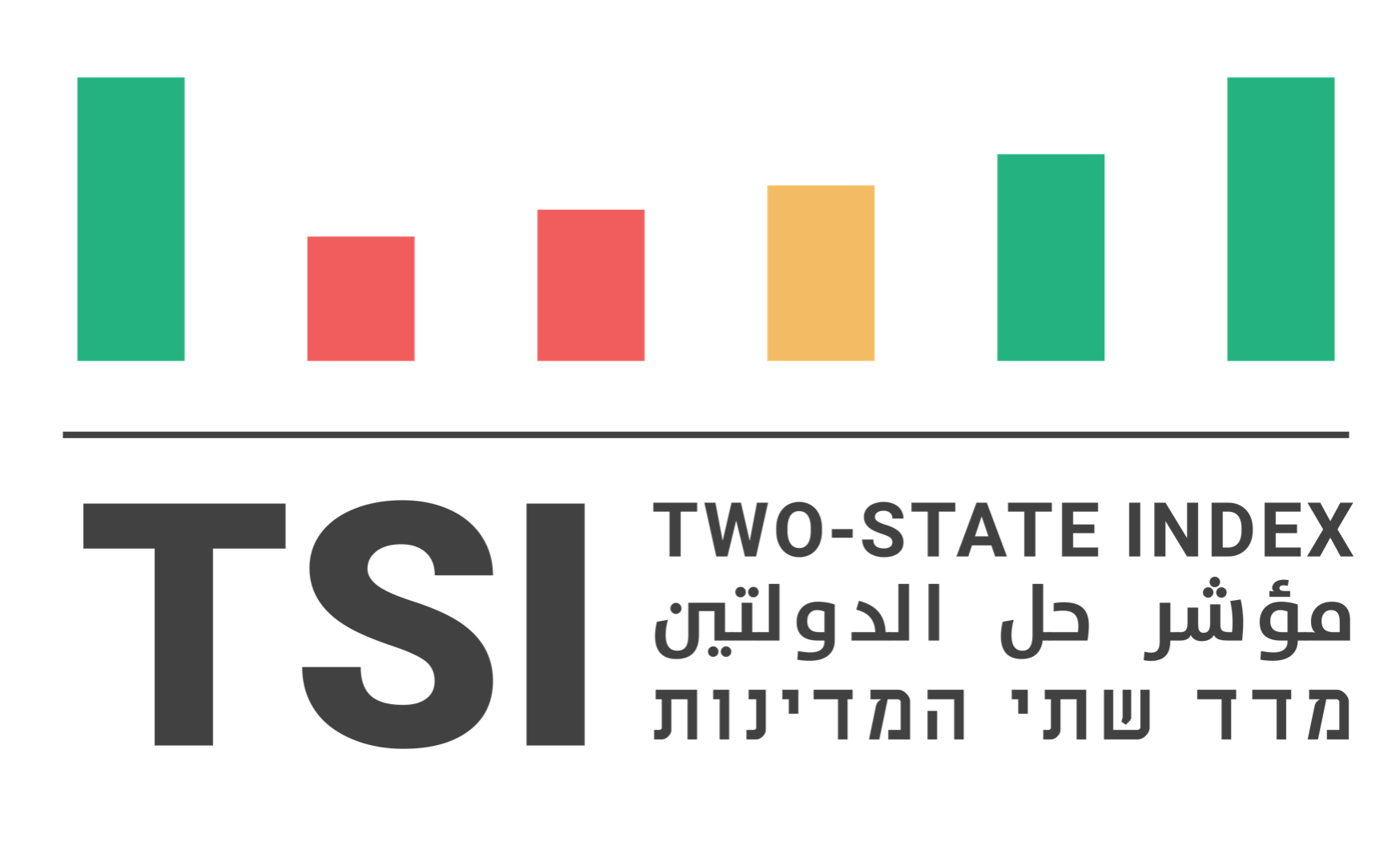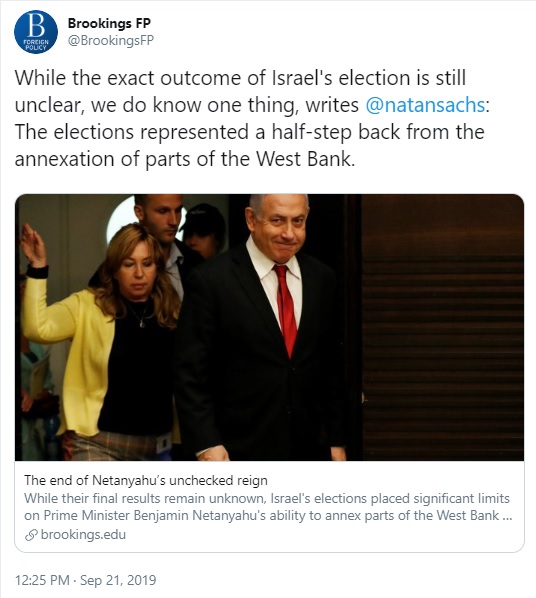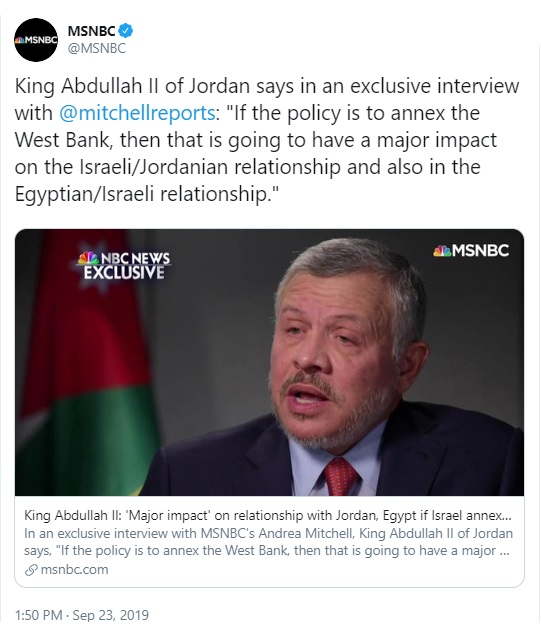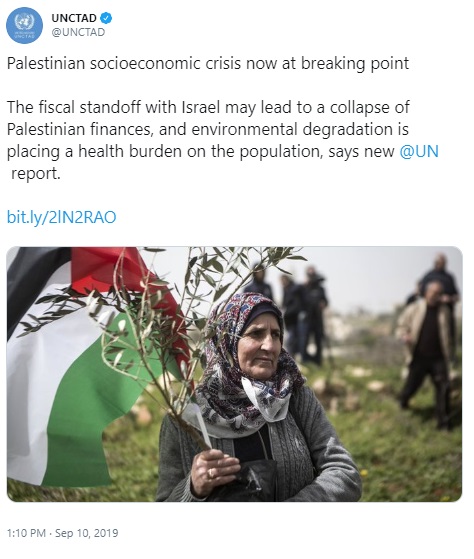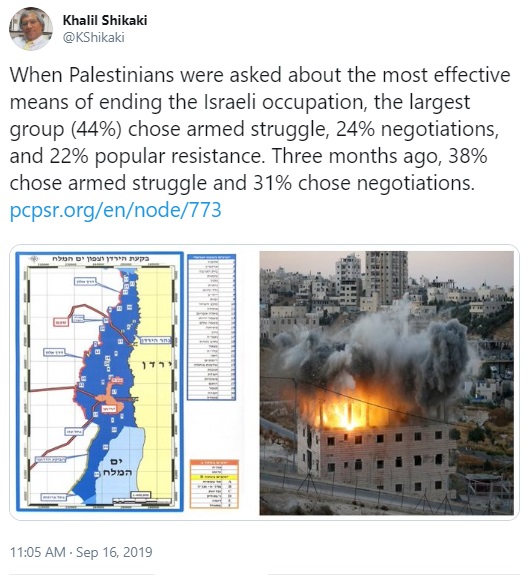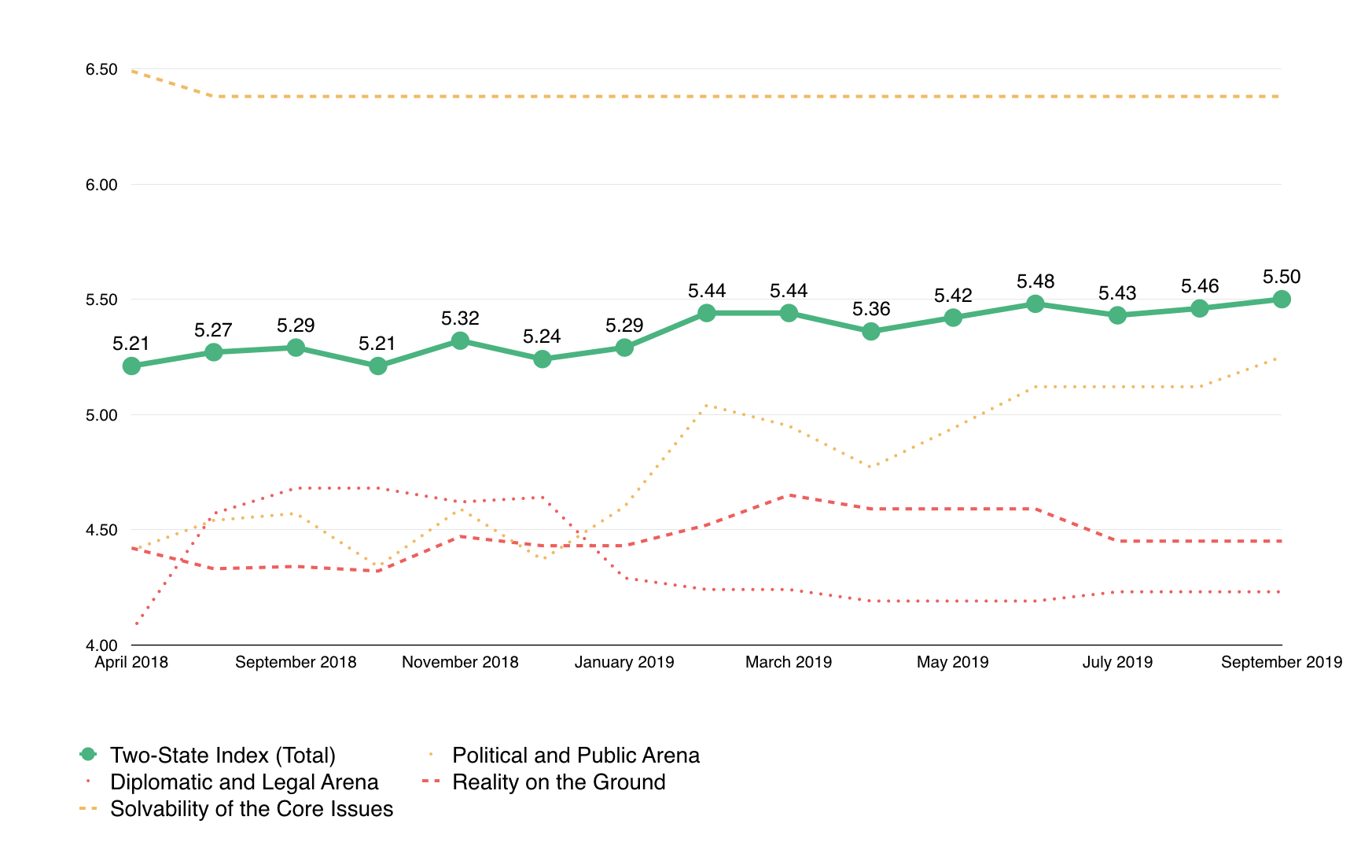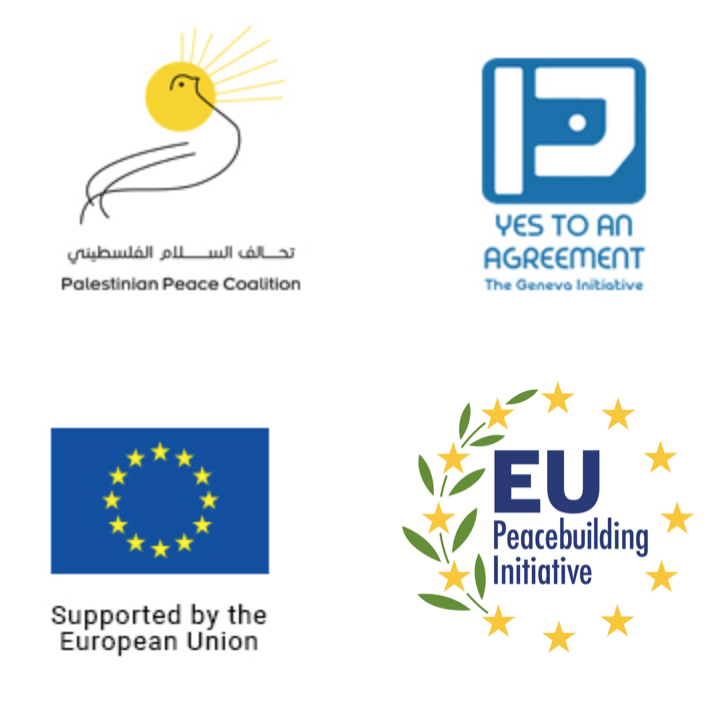Two State Index: September 2019 |
|
|
|
September, in short: - Israeli election outcome positive for two-state supporters: Results prove Netanyahu’s annexation pledge a failure in attracting support from the Israeli public
- Annexation vow met with condemnation: International community pushes back against any potential action by Israel to annex West Bank territory
- Settlements surge and housing disparity in East Jerusalem: New data on recent rise in East Jerusalem construction and vast disparity in permits given to Israelis and Palestinians
- Warning signs for Palestinian economy: Electricity cuts begin in West Bank as multiple new reports highlight imminent economic danger
- Palestinian public opinion shifting: New poll shows increasing Palestinian frustration with status quo
These events moved the Two-State Index (TSI) up by 0.9% (up by 0.04 points from 5.46 in previous month). |
|
|
|
To learn about the Geneva Initiative's TSI, visit our website. |
|
|
|
Results of Israel’s election show potentially positive signs for two-state solution
The outcome of Israel’s national election on September 17 did not lead to a governing majority for either the Blue and White party of Benny Gantz (leading a center-left bloc of parties totaling 57 seats), or for Benjamin Netanyahu’s Likud (leading a right-wing bloc of 55 seats). Despite being given the nod by President Rivlin to form a coalition, Netanyahu’s chances of doing so are not high. It is thus unclear whether Israel is heading towards a new government, headed by Netanyahu or Gantz, or to new elections.
What was clear from the election, however, is that the Israeli public did not favor Netanyahu’s proposals that would effectively preclude any possibility of a two-state solution. Netanyahu’s vow to apply Israeli sovereignty over most West Bank settlements, and his subsequently announced plan to annex the Jordan Valley and Northern Dead Sea area, were part of his efforts to attract more votes in the waning days of the election. Ultimately, Netanyahu inadvertently demonstrated the lack of support among the Israeli public for implementing any of these West Bank annexation measures.
In effect, not only did Netanyahu fail to attract more voters to Likud, but his party lost a net total of 9 seats compared to the April election. After absorbing the Kulanu and Zehut parties, Likud dropped from the equivalent of 41 seats to 32 in September. Netanyahu’s annexation rhetoric is now a proven electoral failure, and the Knesset now contains fewer members who explicitly oppose a two-state solution.
The results of the election also had ramifications for the Trump administration’s approach toward Israeli-Palestinian peace. Prior to the election, the Trump’s Middle East team had begun using the term “vision” instead of “plan” when referring to their long-delayed document that would purportedly lay out the basis for a peace agreement. In announcing his imminent departure from his role as Middle East Envoy, Jason Greenblatt referred multiple times to this “vision”, suggesting that the Trump administration’s effort, if indeed it does ever come to fruition, will not be part of an attempt at serious negotiations. With the administration having repeatedly delayed an announcement of their “vision” (apparently a non-starter for the Palestinians) until a new Israeli government could be formed, the likelihood of such an announcement has now been further diminished.
The results of the election shifted the Israeli public opinion parameter from 7 to 8, and the Israeli legislature parameter from 5 to 6. The weight of the US parameter shifted from 5 to 4 given the ongoing impasse in publishing the plan and the reduced effectiveness in its ability to resolve the conflict. |
|
|
|
Netanyahu uses annexation pledge as election tactic; new East Jerusalem data released
Netanyahu’s pledge to annex the Jordan Valley and other areas of the West Bank provoked condemnation from the entire international community, with UN chief Antonio Guterres asserting that such a move would be “a serious violation of international law.” Jordan’s King Abdullah II subsequently said that any move towards annexation would have a “major impact” on Israeli ties with Jordan and Egypt. The US was the only outlier among major powers, saying only that “there is no change in United States policy at this time.”
Meanwhile, a new report was released on September 12 which showed that settlement construction in East Jerusalem has increased substantially since Donald Trump became US president in 2017. The report from Peace Now showed a 60% increase in construction between 2017 and 2019 relative to the previous two years. It also provided data on the vast discrepancy in the number of construction permits granted to Israelis and Palestinians in East Jerusalem, with Palestinians having received only 30% of building permits issued since 1991 despite comprising more than 60% of the population.
Despite these developments, no significant moves made to expand settlements in September, and all relevant parameters therefore remained the same. |
|
|
|
New warnings for Palestinian economy
There were new, troubling signs for the Palestinian economy last month. On September 22, the Israeli Electricity Company began cutting power in the West Bank for two hours each day, due to outstanding debts. According to The Portland Trust, this action, affecting East Jerusalem, Ramallah, Bethlehem, Jericho and the surrounding areas, “will add to the already strained economic activity in the West Bank under the current fiscal crisis and … will potentially paralyze all aspects of life across socio-economic classes.”
This development comes on the heels of multiple reports warning of the dire Palestinian economic situation. According to a report issued by the United Nations Conference on Trade and Development (UNCTAD) on September 11, the fiscal shock resulting from the Palestinian Authority’s cuts to social assistance and public employee salaries is likely to accelerate the recent fall in per capita income, increased poverty and unemployment, and continuing environmental damage. All of these trends were cited as effects of military occupation, declining donor support, and little hope for political progress. Subsequent reports from the World Bank and UNSCO stressed the danger and imminent consequences resulting from the fiscal crisis confronting the Palestinian Authority, which currently faces a $1.8 billion financial gap.
While these warnings portend major difficulties for the Palestinian economy, the relevant parameters were unchanged in September
|
|
|
|
Shifts in Palestinian public opinion
A new poll from the Palestinian Center for Policy and Survey Research found that support for a two-state solution among the Palestinian public has declined to 42%, a drop of 5% from three months ago. The poll also witnessed a rise in Palestinian support for armed attacks, with a plurality of 44% choosing “armed struggle” as the preferred method for ending the occupation.
The decline in support for a two-state solution likely reflects frustration among Palestinians at the lack of progress towards peace. However, it is notable that this option continues to be supported by a plurality of Palestinians, and indicates its durable viability as the only realistic, comprehensive solution to the conflict. The rise in support for armed struggle among Palestinians is another sign of frustration, and one that suggests unwillingness to continue living with the status quo. This unwillingness is, in principle, a positive sign for supporters of the two-state solution.
Therefore, the Palestinian public opinion parameter remained the same. |
|
|
|
The Two-State Index (TSI) is brought to you by the Geneva Initiative, a Palestinian-Israeli organization working to promote a negotiated peace agreement in the spirit of the two-state vision. The TSI is produced by an Israeli-Palestinian team, and reflects a unique bilateral perspective. |
|
|
|
Think we missed something this month? Send us tips and comments here. |
|
|
|
This publication was produced with the financial support of the European Union. Its contents are the sole responsibility of the Geneva Initiative’s Two-State Index (TSI) editorial team and do not necessarily reflect the views of the European Union. |
|
|
|
|
|
|
| Advertisement |
This message was sent byTwo-State Index, H.L. Education for Peace, Geneva Initiative, 33 Jabotinsky rd., Ramat-Gan 525108, Israel, .
You may notify us, any time, for no charge, of your refusal to receive advertisements by sending a refusal message to the address TSI@genevainitiative.org
or by pressing the "unsubscribe" link at the bottom of the message. |
Powered by Publicators
Powered by Publicators
